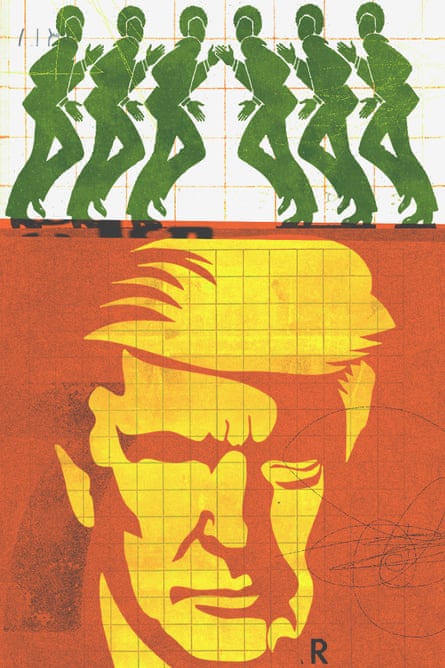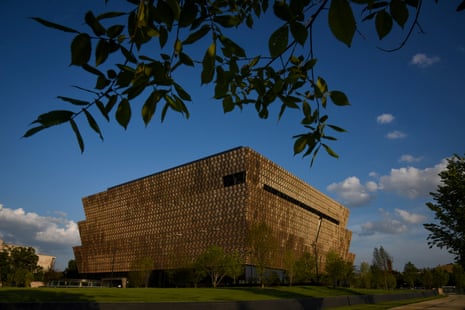Source : Trump is terrified of Black culture. But not for the reasons you think

A look back at 1960s Black arts movement explains why Trump is obsessed with eliminating Black artistry and the museums and institutions that support it
Sun 22 Jun 2025 09.00 EDT
By the time Jesse Owens bowed his head from the highest podium tier to be crowned with his fourth Olympic wreath in the 1936 Berlin Olympics, Europe’s premiers knew they had a problem. In front of a record-setting crowd at games that should have been a lavish display of Aryan propaganda, Owens’s unmatched athleticism on the track humiliated the host Nazi regime and smashed one of the vital ideological pillars upon which European empires annexed the world into their racial order. Since the inception of race-based slavery and settler-colonialism in the 15th century, the novel idea that human beings could be stratified into distinct “races,” with superiority defaulting to white Europeans, was bolstered by the claim that white racial supremacy was the rational outcome of the “natural” biophysical, intellectual and aesthetic ascendancy of white people, and thus of whiteness itself.
Adolf Hitler watched Owens, the five-time world record holder and grandson of enslaved people, triumph in his first event from a lavishly decorated imperial box, and abruptly exited the arena thereafter rather than witness Aryan athletes stumble to place second. In his conspicuous departure, a reluctant admission heard around the world had been made. A pillar was smashed. European physical superiority had been proven an undeniable fallacy and, more insultingly, Black dominance on the track was now a quantifiable fact. The ideological stakes of white supremacy – that whites were the smarter race, the sole ones capable of higher thought, that white people were the most physically beautiful, and also that the cultural products of whiteness were the most artistically valuable to advanced civilization – had suffered a powerful blow and shifted on its heels.

In the 1930s, Hitler and his ministers embarked on a “synchronization” campaign to bring fine arts, theatre, literature, architecture and media in line with Nazi propaganda – a move that was not unique to the Third Reich. All European colonizers expanded their empires via the theft and destruction of the cultures they subjugated, coupled with the intellectual propagandization of their own cultural superiority. Since the world wars, the march of modernity and the inescapability of western cultural imperialism continue to be hedged on that perfectly rigged game in which the products of whiteness are extolled as the most beautiful and significant because white intellectual arbiters tell us that they are.
But in fewer than 40 years following the Berlin games, western empires were swiftly losing their hold on the cultures and minds under their rule. By the late 1960s, a Black freedom struggle in the US ignited a movement for African American identity, inspired by and linked to independence movements throughout the African continent and diaspora. The Black arts movement (BAM), a concerted effort to transform the artistic and cultural vanguard across Black politics, scholarship and organizations in the US, resulted in a creative explosion of cultural production centered on Black life and experience. BAM birthed a new Black consciousness – one sourced from self-determination and aimed squarely at thwarting claims of white cultural supremacy. It brought to the fore a generation of young Black writers, poets, artists, dancers and thespians who asked why any white-controlled institution was qualified to appraise art created for and by Black people.

Jesse Owens running in the 200-meter sprint, for which he set an Olympic record, in Berlin, Germany, on 4 August 1936.Photograph: Brandstaetter Images/Getty Images
When Owens died in 1980 at just 66 years old, having spent his post-Olympiad life subjected to the repeated humiliations of Jim Crow, he and other 20th-century Black athletes had tapped the glass jaw in the myth white superiority and opened the floodgates for BAM’s blitzkrieg against white cultural and intellectual hegemony. The movement was radically forged shifting away from conceding any white cultural supremacy, including a disinterest in white endorsement and patronage. BAM activists built their own institutions including bookstores, publishing houses, theatres, galleries, museums, cultural centers and scholarly journals and digests. Organizers started Black studies programs, conferences and curricula across the country. The movement understood that Black cultural production required Black intellectual production to secure its value and meaning.
The ideological through-line from the overt white supremacy of the past to today is crystal clear. BAM’s legacy can be found in the threat that Black culture and cultural institutions pose to new versions of old authoritarianism. In recent months, the Trump administration has advanced its culture wars to defund, demolish and demote the institutionalization of Black arts and culture, notably through very public takeovers of the Kennedy Center, Library of Congress, and Smithsonian Institution, along with several high-profile firings of Black experts and leadership in these and many other institutions reliant on federal funding.

With book bans and the seizing of administrative, fiscal and curricular control of elite universities, Donald Trump has declared open war on all knowledge and expression that his administration deems anti-white. Much of the public discourse has summed up Trump’s demolition efforts as an assault on diversity, equity and inclusion (DEI) campaigns, and much of that discourse gets it wrong. In patronizing Black culture as merely worthy of representation in white spaces, we misconstrue the endgame of Trump’s white supremacist politics. Trump knows that culture in the hands of subjugated peoples is a political weapon that he can’t best. His lavish attempts at conjuring a culture via pageantry seem pathetic because they are. In a culture war fair fight, where Black people hold power in institutions, knowledge and politics, he will lose.
Hitler wasn’t affronted because Owens was included or represented in the games. The Führer stormed out infuriated after witnessing a Black man win. Even more important than its content, BAM’s great victory was in putting forth an uncomfortable truth for the white mainstream: the cultural contributions of Black people laid bare the sheer fallacy of western cultural eminence. BAM was able to back up that claim with an organized Black scholarly and institutional thrust, thus exposing how claims of white cultural dominance were only buttressed by white political power.
Trump is terrified of Black culture. But not for the reasons you think

A look back at 1960s Black arts movement explains why Trump is obsessed with eliminating Black artistry and the museums and institutions that support it
Sun 22 Jun 2025 09.00 EDT
By the time Jesse Owens bowed his head from the highest podium tier to be crowned with his fourth Olympic wreath in the 1936 Berlin Olympics, Europe’s premiers knew they had a problem. In front of a record-setting crowd at games that should have been a lavish display of Aryan propaganda, Owens’s unmatched athleticism on the track humiliated the host Nazi regime and smashed one of the vital ideological pillars upon which European empires annexed the world into their racial order. Since the inception of race-based slavery and settler-colonialism in the 15th century, the novel idea that human beings could be stratified into distinct “races,” with superiority defaulting to white Europeans, was bolstered by the claim that white racial supremacy was the rational outcome of the “natural” biophysical, intellectual and aesthetic ascendancy of white people, and thus of whiteness itself.
Adolf Hitler watched Owens, the five-time world record holder and grandson of enslaved people, triumph in his first event from a lavishly decorated imperial box, and abruptly exited the arena thereafter rather than witness Aryan athletes stumble to place second. In his conspicuous departure, a reluctant admission heard around the world had been made. A pillar was smashed. European physical superiority had been proven an undeniable fallacy and, more insultingly, Black dominance on the track was now a quantifiable fact. The ideological stakes of white supremacy – that whites were the smarter race, the sole ones capable of higher thought, that white people were the most physically beautiful, and also that the cultural products of whiteness were the most artistically valuable to advanced civilization – had suffered a powerful blow and shifted on its heels.

In the 1930s, Hitler and his ministers embarked on a “synchronization” campaign to bring fine arts, theatre, literature, architecture and media in line with Nazi propaganda – a move that was not unique to the Third Reich. All European colonizers expanded their empires via the theft and destruction of the cultures they subjugated, coupled with the intellectual propagandization of their own cultural superiority. Since the world wars, the march of modernity and the inescapability of western cultural imperialism continue to be hedged on that perfectly rigged game in which the products of whiteness are extolled as the most beautiful and significant because white intellectual arbiters tell us that they are.
But in fewer than 40 years following the Berlin games, western empires were swiftly losing their hold on the cultures and minds under their rule. By the late 1960s, a Black freedom struggle in the US ignited a movement for African American identity, inspired by and linked to independence movements throughout the African continent and diaspora. The Black arts movement (BAM), a concerted effort to transform the artistic and cultural vanguard across Black politics, scholarship and organizations in the US, resulted in a creative explosion of cultural production centered on Black life and experience. BAM birthed a new Black consciousness – one sourced from self-determination and aimed squarely at thwarting claims of white cultural supremacy. It brought to the fore a generation of young Black writers, poets, artists, dancers and thespians who asked why any white-controlled institution was qualified to appraise art created for and by Black people.

Jesse Owens running in the 200-meter sprint, for which he set an Olympic record, in Berlin, Germany, on 4 August 1936.Photograph: Brandstaetter Images/Getty Images
When Owens died in 1980 at just 66 years old, having spent his post-Olympiad life subjected to the repeated humiliations of Jim Crow, he and other 20th-century Black athletes had tapped the glass jaw in the myth white superiority and opened the floodgates for BAM’s blitzkrieg against white cultural and intellectual hegemony. The movement was radically forged shifting away from conceding any white cultural supremacy, including a disinterest in white endorsement and patronage. BAM activists built their own institutions including bookstores, publishing houses, theatres, galleries, museums, cultural centers and scholarly journals and digests. Organizers started Black studies programs, conferences and curricula across the country. The movement understood that Black cultural production required Black intellectual production to secure its value and meaning.
The ideological through-line from the overt white supremacy of the past to today is crystal clear. BAM’s legacy can be found in the threat that Black culture and cultural institutions pose to new versions of old authoritarianism. In recent months, the Trump administration has advanced its culture wars to defund, demolish and demote the institutionalization of Black arts and culture, notably through very public takeovers of the Kennedy Center, Library of Congress, and Smithsonian Institution, along with several high-profile firings of Black experts and leadership in these and many other institutions reliant on federal funding.

With book bans and the seizing of administrative, fiscal and curricular control of elite universities, Donald Trump has declared open war on all knowledge and expression that his administration deems anti-white. Much of the public discourse has summed up Trump’s demolition efforts as an assault on diversity, equity and inclusion (DEI) campaigns, and much of that discourse gets it wrong. In patronizing Black culture as merely worthy of representation in white spaces, we misconstrue the endgame of Trump’s white supremacist politics. Trump knows that culture in the hands of subjugated peoples is a political weapon that he can’t best. His lavish attempts at conjuring a culture via pageantry seem pathetic because they are. In a culture war fair fight, where Black people hold power in institutions, knowledge and politics, he will lose.
Hitler wasn’t affronted because Owens was included or represented in the games. The Führer stormed out infuriated after witnessing a Black man win. Even more important than its content, BAM’s great victory was in putting forth an uncomfortable truth for the white mainstream: the cultural contributions of Black people laid bare the sheer fallacy of western cultural eminence. BAM was able to back up that claim with an organized Black scholarly and institutional thrust, thus exposing how claims of white cultural dominance were only buttressed by white political power.
Last edited:


























